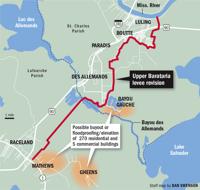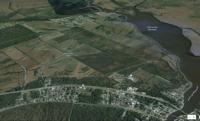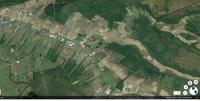Posted on January 14, 2021
The Army Corps of Engineers has unveiled a revised, 30-mile-long Upper Barataria levee system that would cost nearly $2 billion and protect portions of seven south Louisiana parishes, including the west banks of Jefferson, St. Charles and St. John the Baptist, from hurricane flooding.
The proposal would be designed to protect against flooding caused by hurricane surges that have a 1% chance of occurring in any year, a so-called 100-year storm event. If built, the new system would extend to more than 360,000 vulnerable West Bank residents of six parishes the same reduced level of storm surge damage now experienced by New Orleans area residents within the post-Hurricane Katrina levee system.

In 2019, the Corps released a more modest plan that included only 18.3 miles of new levees and improvements to existing levees. That plan only provided a 50-year level of protection from storm surges; it allowed some surge water from larger storms to overtop the levees and be stored in wetlands north and west of the levee system.
Corps officials said the decision to abandon that plan was made after the proposal was tested using modeling run by the state Coastal Protection and Restoration Authority as part of its 2017 coastal Master Plan design.
The model runs indicated the agency’s initial damage estimates from overtopping were far too low, especially as water levels along the Gulf Coast rise in the coming years because of global warming. Because of this, that the first version no longer made sense from a cost-benefit perspective.
The new design results in a benefit-to-cost ratio of 1.3, enough to meet requirements set by the Corps for similar levee projects. Without the levees, 6,430 structures would have flood damage during a 100-year event, compared to only about 145 structures with the project.
Because the project also protects U.S. 90 from surges, the new levee system would help with hurricane evacuations and the transport of supplies to communities after a hurricane.
The new design will require levee segments to initially be built or elevated to between 12.5 and 14 feet, with construction to start in 2023 and be completed by the end of 2026.
Levee segments already under construction — either as the western floodwall along the Davis Pond freshwater diversion at the Mississippi River, or as part of levee systems already built or under construction by St. Charles and Lafourche parish levee agencies — have been or are being built to 7.5 feet above sea level.
To deal with expected future sea level rise, segments of the new levee system could eventually be elevated to between 16 and 18.5 feet above sea level before the end of the project’s 50-year lifetime.
The southern end of the levee system, near Raceland, will eventually tie in to the planned eastern end of the Morganza-to-the-Gulf levee system that extends to the south around Houma.
The project also includes a floodgate on Bayou Des Allemands that would be closed for hurricanes.
The project also estimates that it might cost $84 million to either buy out, floodproof or elevate 270 residences and businesses on the unprotected side of the system in the towns of Bayou Gauche, Mathews and Gheens, which will likely see higher surge levels after the levees are completed.
Corps officials say the structures in Bayou Gauche are the most likely to be included in such a program, while further investigations will be needed for buildings in Mathews and Gheens.
They estimate it will require $400 million to develop projects to mitigate for the environmental effects of the lengthy levee system. Travis Creel, a Corps official helping oversee the project, said the agency will work with the CPRA to determine if any of that money can be used for projects that already are part of the state’s Master Plan. The Corps could also use the money to buy credits in privately operated “mitigation banks.”
The revised proposal will be the the subject of online virtual public meetings at 10 a.m. Tuesday and 2 p.m. Wednesday. The meetings will be presented on WebEx and will be streamed on the district’s Facebook page. Information on how to log in for the meetings, and how to view documents related to the study, is available at:
https://www.mvn.usace.army.mil/About/Projects/BBA-2018/studies/Upper-Barataria-Louisiana/
Comments on the plan will be accepted during the meetings via WebEx and Facebook, by text or voicemail at 318.469.8350, or by email at UpperBaratariaFS@usace.army.mil.
Written comments can be mailed to U.S. Army Corps of Engineers; Attention: Program Management; CEMVN-PMR, Room 331; 7400 Leake Ave.; New Orleans LA 70118
A major challenge remains for the proposed levee system, even if it is eventually approved — money.
The existing design work is being paid for by the Corps under a special program that authorizes the agency to develop such initial proposals for projects considered of national importance.
But because of its size, the project likely will need congressional approval as part of a future Water Resources Development Act, legislation that usually only occurs every two years. The most recent version of that bill was just approved by Congress last week.
That is likely to require an agreement by the state to pay for 35% of the construction costs, which also will be required for the Corps to include its own 65% share of the construction expenses in one or more future appropriations budgets.
And the state will have to guarantee that it or local officials will pay the more-than $2 million annual operation and maintenance costs for the system. Additional levee lifts during its 50-year lifespan are built into the initial cost, and would be shared by the Corps and local sponsors, though the money won’t be required until needed.
State officials are in favor of the plan, as a version of the levee system was included in the 2017 coastal Master Plan update. But the state has not yet identified a funding source, and this new levee would have to compete with other levees much farther along in planning and construction for scarce state dollars.
Local taxes authorized by St. Charles Parish and Lafourche levee authorities will also go toward the project, but are not expected to be enough to account for the state’s entire share.
The state also will be required to pay upfront for any land acquisition costs, and while that money is likely to be allowed to offset part of its 35% share, if the land acquisition is more than that share, the state must pay all of it.
There’s also a possibility that the state could use money set aside for coastal restoration projects to offset the part of the project cost required for environmental mitigation.
Source: nola













